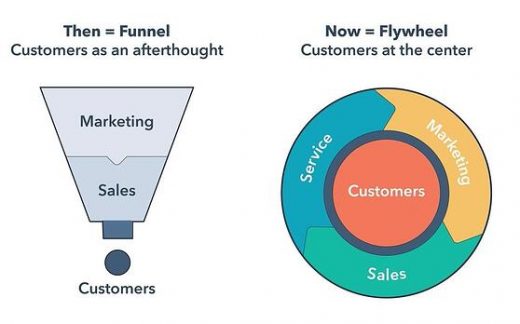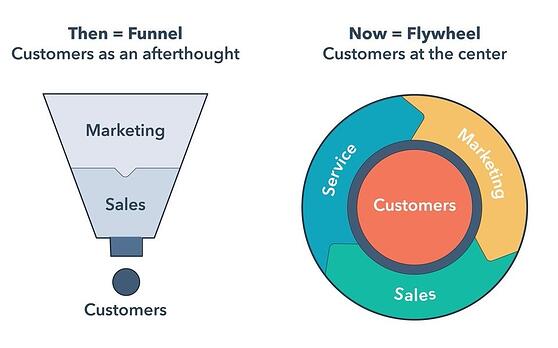The Fly Wheel Isn’t a Marketing Tool – It’s a Business Model Tool
What Is The Marketing Flywheel?
The Marketing FlyWheel is a tool that allows you to focus on your customers rather and drive business through them. The idea is that the outcome of your marketing is customer-focused rather than focused on benefiting you! While a lot of companies already do this to a certain point the Marketing FlyWheel takes a fresh approach to it.
- The main sections to the marketing funnel are to
- Attract (gain new business and get people’s attention)
- Engage (engage with your business such as lead forms)
- Delight (keep the customer delighted whilst using your services)
Ultimately the marketing flywheel is designed to look at how your business interacts with your customers and makes sure it’s engaging at every single touch point with the aim to get those customers to attract you more business.
Marketing Flywheel Vs The Marketing Funnel
Everyone’s talking about the marketing flywheel and how it’s going to replace the marketing funnel. In my opinion they are two very different models and one relies on the other.
If you look at the attract element of the flywheel, in order to get customers in the first place you’re going to need to attract them. you need to be thinking about your marketing funnel to get them into the Flywheel in the first place.
How they can exist independent of each other does not make sense to me
The Flywheel, Is It Really A Marketers Tool?
Here is an issue I have with the flywheel, it’s been labeled as a marketers tool as it essentially replaces the marketing funnel.
While marketing is often the first point of contact for the customer it’s important to note that a marketer does not have control over the sales and customer service aspects of a business. This makes it unrealistic to put a marketer as the owner of the Fly Wheel.
So who should own the Fly Wheel?
The salespeople and customers service operators are in the same dilemma, they are also don’t have control over the other elements of the flywheel.
The only person who has the ability to drive and ensure consistency across the flywheel is the owner or managing director of the business. They are generally the only people who have influence over these 3 parts of the business.
It’s Not For Any Business Owner
To win at the flywheel you have to be courageous as the owner, your employees and even contractors have to want to delight your customers and then you need to manage and measure success. You must be able to understand the role of the manager and leader and know when you need to switch from being a manager to a leader in order to drive your team.
“Managers look after planning and processes whereas Leaders inspire and lead their team members. The Coach role is another facet of the leadership role.” – LBS Partners
In order for the Flywheel to work you need to be a leader and drive customer engagement through your employees, you then need to be able to manage tasks and measure accurately to make sure you’re on track
Dissecting The Marketing Flywheel
While going through the process of understanding how the flywheel works I’ve come to the realisation that the Fly Wheel
- Isn’t a marketing tool
- Isn’t for the marketer but actually for the business owner
- Focuses on the business processes more than marketing
Which leads me to my theory, that the Flywheel is looking at your business model and focusing on the touch points a customer will use during their journey.
If its not a marketing tool and the marketing team can’t own it then I don’t think it should be called the marketing flywheel.
The Business Model Canvas
For those of you who don’t know what the business model canvas is. It’s a tool a lot of start ups use to identify how their business is going to work and make money. It was developed by Strategyzer who also have another great tool called the value proposition map, a breakaway tool from the canvas worth checking out if you have the time.
Both will really help you understand your customers needs, much like how the flywheel forces you to look at your customers.
There are 9 basic building blocks that you need to understand
- Customer segments – all the people who you are creating value for / customers
- Value proposition – products and services and how they deliver value
- Channels – how you interact with customers (marketing and service delivery)
- Customer relationships – what sort of relationship will you have (self service, sales rep etc)
- Revenue generated – how do people and companies pay you
- Key resources – what do you definitely need to run your business
- Key activities – what actions do you need to do in order to create your product and add value
- Key partnerships – who can help you leverage your business
- Cost structure – looking at the above what costs are involved
These help you map out how your business works, delivers value to the customer and how you can make a profit at the end of it all.
The Business Model Canvas Vs The Marketing FlyWheel
The Business Model Canvas goes in depth, focusing on how the business makes money while the Marketing FlyWheel focuses only on the segments of your business a customer will interact with.
When we take the 9 building blocks from the business model canvas and look at how the Marketing FlyWheel overlaps it’s quite clear that a customer touches or is influenced by every block.
The Difference Is:
- Your FlyWheel is focusing on the customer and aims to delight them
- Your Business Model Canvas focuses more on how the business makes money
Does the Flywheel Replace The Canvas?
No, they definitely work alongside each other. What I’ve found is that the marketing FlyWheel addresses a pain point I think a lot of companies face which is trying to get marketing, sales and customer service representatives working together.
It allows for your teams to break down their role and open up conversations as to how you can improve customer journeys through your business.
It will help improve:
- Passing leads and customers through the business
- Help with consistent messaging
- Feed information from one team to the next
Ultimately leading to a very happy customer experience who wants to tell everyone about your service and attract you new customers.
What To do Next?
Here are the key takeaways from this article, keep them in mind as you begin to introduce the marketing flywheel into your business
- The Marketing Flywheel has to be lead by the business owner in my opinion
- It’s not to replace the marketing funnel as you will still want to attract new customers outside of your business
- It’s an aid similar to the business model canvas but shouldn’t replace the canvas
- It allows you to focus on your business from your customers perspective
- It’s a very useful tool to get your teams discussing how to improve the customer experience
The marketing flywheel will only work when everyone has bought into the idea of the marketing funnel. It is definitely a tool that will help you grow your business, delight your customers and drive more sales but I would suggest not dropping your existing marketing strategies, but more incorporate the flywheel into your strategy.
Hubspot goes into more depth on how to drive the flywheel where they talk about “Friction” & “Force”.
Friction
You need to make it as easy as possible for a client to move through your business which reduces friction.
Force
The easier people make it through your funnel the more customers you have delighted and this in turn adds force as they go out and tell others, attracting them to the business.
Digital & Social Articles on Business 2 Community
(86)



